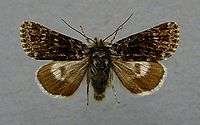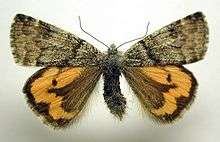Catocala
- Eucorna and Lamprosia redirect here. For the metalmark butterfly and arctiid moth genera, respectively, see Voltinia (butterfly) and Lamprosiella.
| Catocala | |
|---|---|
| | |
| Semirelict underwing (C. semirelicta) Imago of the pura form from above | |
| Scientific classification | |
| Kingdom: | Animalia |
| Phylum: | Arthropoda |
| Class: | Insecta |
| Order: | Lepidoptera |
| Superfamily: | Noctuoidea |
| Family: | Erebidae |
| Tribe: | Catocalini |
| Genus: | Catocala Schrank, 1802 |
| Type species | |
| Phalaena nupta Linnaeus, 1767 | |
| Diversity | |
| About 270 species | |
| Synonyms | |
|
Numerous, see text | |
Catocala is a generally Holarctic genus of moths in the Erebidae family. The moths are commonly known as underwing moths or simply underwings. These terms are sometimes used for a few related moths, but usually – especially when used in plural, not as part of a species name – they are used to refer to Catocala only.
Of the more than 250 known species, slightly less than half are found in North America – mostly in the United States – while the rest occur in Eurasia. About one-fifth (almost 30) of these species are native to Europe. A few species occur in the northern Neotropics and Indomalaya.[1]
Description and ecology
Most species of Catocala have medium to large adults, cryptically coloured except for the hindwings, which are marked with stripes in orange, red, white, or even blue. In some, the hindwings are mostly blackish. Unlike what the common name "underwings" seems to suggest, the colour is brightest on the upperside. However, the bright hindwings are not visible at rest, being hidden under the dull forewings – hence the name. Due to their diversity and variety of colors and patterns, underwing moths are popular with collectors of Lepidoptera.
In, The Fauna of British India Including Ceylon and Burma, Moths Vol. II, the genus described as follows.
"Palpi reaching just above vertex of head, the 2nd joint thickly scaled; antennae of male fasciculated; thorax smoothly scaled; abdomen with dorsal ridges of coarse hair on proximal segments, which are sometimes developed into tufts; fore tibia more or less hairy; hind tibia spined. Fore wing with the apex nearly rectangular; the cilia crenulate. Hind wing with the cilia crenulate; vein 5 from below center of discocellulars. Larva with four pairs of abdominal prolegs."
—The Fauna of British India Including Ceylon and Burma, Moths Vol. II[2]
It is believed that the bright colors, arranged in usually roughly concentric markings, at a casual glance resemble the eyes of a predatory animal, such as a cat. An underwing moth, well camouflaged in its daytime resting spot on a tree trunk or branch, will suddenly flash open the hindwings when disturbed. A bird or other small predator that is not used to this display is likely to be frightened, allowing the moth to escape. However, unlike some other bright-colored moths which are bad-tasting or even poisonous to predators, underwing moths are well palatable at least to some birds (e.g. the blue jay, Cyanocitta cristata). To assist in avoiding nocturnal predators such as bats, these moths also possess (like many of their relatives) fairly well-developed hearing organs.[3]
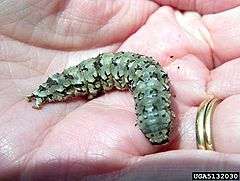
The caterpillars of most species feed on the leaves of woody plants, usually trees but sometimes shrubs. Typical food plants are Fagales of the families Betulaceae, Fagaceae and Juglandaceae – mainly hickory (Carya), oak (Quercus) and walnut tree (Juglans) species, as well as others such as alder (Alnus), beech (Fagus), birch (Betula) and chestnut (Castanea). The caterpillars of numerous Old World and some North American species feed on the Salicaceae Populus (poplars) and Salix (willows), which belong to the Malpighiales. Less common larval food plants of Catocala are for example elms (Ulmus) and various Rosaceae of the Rosales, Tilia (linden and basswood) of the Malvales, or some Fabaceae of the Fabales; as the preceding, these all belong to the Fabidae lineage of rosid eudicots. More unusually, underwing moth caterpillars have also been found to feed on such plants as maple (Acer) which belongs to a distant lineage of rosids, as well as on such plants as ash trees (Fraxinus) and blueberries (Vaccinium) which are asterids and quite unrelated to the other food plants by eudicot standards.[4]
The adults are predominantly nocturnal, flying from shortly after dusk right up to daybreak. They are generally most active about two hours after nightfall. However, several if not all species of underwing moths have a second activity period exactly around noon, during which they are also regularly found on the wing for about 1–2 hours each day.[5]
The genus name Catocala roughly means "beautiful hindwings". It is a combination of two Ancient Greek words, kato (κάτω, "the rear one" or "the lower one"), and kalos (καλός, "beautiful").[6]
Classification
The species of Catocala are here divided into a Eurasian group, and another one which is found in North America. This does not imply actual relationships; it is mainly done to more conveniently deal with the large number of species. Still, it is not unlikely at all that the groups consist at least to some extent of closely related species.[7]
There are several cryptic species complexes in Catocala, e.g. the group around the Delilah underwing (C. delilah); these and other hitherto unknown species are still being discovered and described in some numbers. Thus, resolving the phylogeny and taxonomy of the underwing moths is an ongoing effort, which has made (as of 2011) little progress. In the scientific literature, smaller subdivisions into putatively related species are sometimes applied, but there is no consistent and widely accepted taxonomic treatment for the genus as a whole.
Synonyms
Several distinct genera have formally been proposed for splitting from Catocala, but these are all treated here as junior synonyms. These synonyms and other invalid names of Catocala are:[8]
- Andreusia Hampson, 1913 (unjustified emendation)
- Andrewsia Grote, 1882
- Astiodes (lapsus)
- Astiotes Hübner, 1823
- Belpharidia (lapsus)
- Blephara Ochsenheimer, 1816 (unavailable)
- Blepharidia Hübner, 1822
- Blepharonia Hübner, 1823 (unavailable)[9]
- Blepharonia Hübner, 1825
- Blepharum Hübner, 1806 (rejected)
- Catabapta Hulst, 1884
- Catacola (lapsus)
- Catocalla (lapsus)
- Corisce Hübner, 1823
- Corisee (lapsus)
- Ephesia Hübner, 1818
- Eucora Hübner, 1823
- Eunetis Hübner, 1823
- Hemigeometra Haworth, 1809
- Lamprosia Hübner, [1821]
- Lamprosia Hübner, 1827 (non Hüber, [1821]: preoccupied)
- Mormonia Hübner, 1823
- Mormosia (lapsus)
Palearctic species
- Catocala abacta
- Catocala abamita (including C. scortum)
- Catocala actaea
- Catocala adultera
- Catocala aenigma Sheljuzhko, 1943
- Catocala aestimabilis
- Catocala afghana Swinhoe, 1885
- Catocala agitatrix (including C. mabella)
- Catocala amabilis
- Catocala amnonfreidbergi
- Catocala ariana Vartian, 1964
- Catocala armandi (including C. davidi)
- Catocala artobolevskiji Sheljuzhko, 1943
- Catocala bella (including C. serenides)
- Catocala bokhaica
- Catocala borthi Saldaitis, Ivinskis, Floriani & Babics, 2012
- Catocala brandti
- Catocala butleri
- Catocala catei Weisert, 1998
- Catocala chenyixini Ishizuka, 2011
- Catocala columbina
- Catocala coniuncta – Minsmere crimson underwing
- Catocala connexa
- Catocala contemnenda
- Catocala conversa
- Catocala danilovi Bang-Haas, 1927
- Catocala dariana Sviridov, Speidel, Reshöft, 1996
- Catocala davidi Oberthür, 1881
- Catocala deducta Eversmann, 1843
- Catocala dejeani (sometimes in C. kuangtungensis)
- Catocala desiderata
- Catocala detrita Warren, 1913
- Catocala deuteronympha
- Catocala dilecta Hübner, [1808] (type of Astiotes)
- Catocala disjuncta
- Catocala dissimilis (including C. nigricans)
- Catocala distorta Butler, 1889
- Catocala diversa
- Catocala doerriesi
- Catocala dotatoides
- Catocala dula
- Catocala duplicata
- Catocala editarevayae
- Catocala electa – rosy underwing
- Catocala ella Butler, 1877
- Catocala ellamajor Ishizuka, 2010
- Catocala elocata – French red underwing
- Catocala eminens Staudinger, 1892
- Catocala eutychea
- Catocala flavescens
- Catocala florianii Saldaitis & Ivinskis, 2008
- Catocala formosana Okano, 1958
- Catocala fraxini – blue underwing, Clifden Nonpareil (type of Hemigeometra)
- Catocala fredi Bytinsky-Salz & Brandt, 1937
- Catocala fugitiva Warren, 1914
- Catocala fulminea (type of Ephesia)
- Catocala fuscinupta
- Catocala gansan Ishizuka & M. Wang, 2013
- Catocala giuditta Schawerda, 1934
- Catocala haitzi Bang-Haas, 1936
- Catocala hariti Ishizuka & Ohshima, 2002
- Catocala helena
- Catocala hoenei Mell, 1936
- Catocala hoferi Ishizuka & Ohshima, 2003
- Catocala hymenaea
- Catocala hymenoides Draeseke, 1927
- Catocala hyperconnexa Sugi, 1965
- Catocala inconstans Butler, 1889
- Catocala infasciata Mell, 1936
- Catocala intacta
- Catocala invasa
- Catocala jansseni Prout, 1924
- Catocala jonasii Butler, 1877
- Catocala jouga Ishizuka, 2003
- Catocala juncta
- Catocala jyoka Ishizuka, 2006
- Catocala kaki Ishizuka, 2003
- Catocala kasenko Ishizuka, 2007
- Catocala koreana Staudinger, 1892
- Catocala kotschubeyi Sheljuzhko, 1927
- Catocala kuangtungensis
- Catocala kusnezovi Püngeler, 1914
- Catocala lara Bremer, 1861
- Catocala largeteaui Oberthür, 1881
- Catocala laura Speidel, Ivinskis & Saldaitis, 2008
- Catocala leechi
- Catocala lehmanni Speidel, Ivinskis & Saldaitis, 2008
- Catocala lesbia
- Catocala longipalpis Mell, 1936
- Catocala lupina Herrich-Schäffer, [1851]
- Catocala luscinia Brandt, 1938
- Catocala maculata Vincent, 1919
- Catocala mariana
- Catocala martyrum Oberthür, 1881
- Catocala maso Ishizuka, 2011
- Catocala mesopotamica
- Catocala mirifica Butler, 1877
- Catocala moltrechti Bang-Haas, 1927
- Catocala musmi
- Catocala naganoi Sugi, 1982
- Catocala nagioides
- Catocala naumanni Sviridov, 1996
- Catocala neglecta
- Catocala neonympha Esper, 1805 (type of Eucora)
- Catocala nivea Butler, 1877
- Catocala nubila
- Catocala nupta – red underwing
- Catocala nymphaea
- Catocala nymphaeoides Herrich-Schäffer, 1852
- Catocala nymphagoga – oak yellow underwing
- Catocala oberthueri Austaut, 1879
- Catocala obscena Alphéraky, 1879
- Catocala ohshimai Ishizuka, 2001
- Catocala olgaorlovae
- Catocala optata
- Catocala optima – Turanga underwing
- Catocala pacta
- Catocala paki Kishida, 1981
- Catocala patala Felder & Rogenhofer, 1874
- Catocala pataloides
- Catocala persimilis
- Catocala pirata
- Catocala praegnax Walker, 1858
- Catocala prolifica Walker, 1857
- Catocala promissa – light crimson underwing
- Catocala proxeneta Alphéraky, 1895
- Catocala pudica Moore, 1879
- Catocala pudica sabine Saldaitis, Pekarsky & Borth 2014
- Catocala puella
- Catocala puerpera (type of Eunetis)
- Catocala puerperoides
- Catocala remissa
- Catocala repudiata
- Catocala rhodosoma Röber, 1927
- Catocala seibaldi Saldaitis, Ivinskis & Borth, 2010 (including C. pseudoformosana)
- Catocala seiohbo
- Catocala separans
- Catocala separata
- Catocala sinyaevi Sviridov, 2004
- Catocala solntsevi
- Catocala sponsa – dark crimson underwing
- Catocala sponsalis
- Catocala stamensis Kishida & Suzuki, 2002
- Catocala streckeri
- Catocala sultana (sometimes in C. optata)
- Catocala svetlana Sviridov, 1997
- Catocala szechuena
- Catocala tapestrina Moore, 1882
- Catocala thomsoni Prout, 1924
- Catocala timur – Timur underwing
- Catocala tokui
- Catocala toropovi Saldaitis, Kons & Borth, 2014
- Catocala triphaenoides Oberthür, 1881
- Catocala uljanae Sinyaev, Saldaitis & Ivinskis, 2007
- Catocala viviannae
- Catocala weigerti Hacker, 1999
- Catocala wushensis
- Catocala xarippe Butler, 1877 (formerly in C. fulminea)
- Catocala xizangensis Chen, 1991
Comparison of Eurasian species
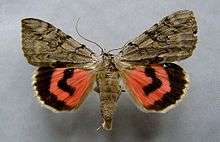 Catocala electa
Catocala electa
rosy underwing Catocala elocata
Catocala elocata
French red underwing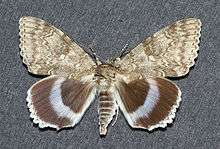
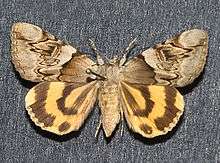 Catocala fulminea
Catocala fulminea
type species of Ephesia
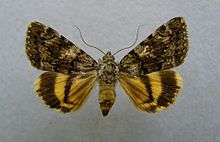 Catocala nymphagoga
Catocala nymphagoga
oak yellow underwing Catocala promissa
Catocala promissa
light crimson underwing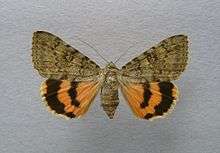 Catocala puerpera
Catocala puerpera
type species of Eunetis Catocala sponsa
Catocala sponsa
dark crimson underwing
Nearctic species
- Catocala abbreviatella
- Catocala agrippina – Agrippina underwing
- Catocala aholibah – Aholibah underwing
- Catocala alabamae – Alabama underwing, titan underwing (including C. olivia, C. titania)
- Catocala allusa (sometimes in C. faustina)
- Catocala amatrix – sweetheart underwing (type of Lamprosia)
- Catocala amestris – three-staff underwing
- Catocala amica – girlfriend underwing (type of Corisce)
- Catocala andromache – Andromache underwing
- Catocala andromedae – Andromeda underwing, gloomy underwing
- Catocala angusi – Angus' underwing
- Catocala antinympha – sweetfern underwing (type of Catabapta)
- Catocala atocala – Atocala underwing, Brou's underwing
- Catocala badia – bay underwing, bayberry underwing, "old maid"
- Catocala benjamini – Benjamin's underwing (formerly in C. andromache)
- Catocala blandula – charming underwing
- Catocala briseis – Briseis underwing, ribbed underwing
- Catocala caesia – bluish-gray underwing
- Catocala californica (including C. erichi)
- Catocala californiensis
- Catocala cara – darling underwing
- Catocala carissima – carissima underwing (formerly in C. cara)
- Catocala cerogama – yellow-banded underwing
- Catocala charlottae (sometimes in C. praeclara)
- Catocala chelidonia
- Catocala cleopatra (sometimes in C. faustina)
- Catocala clintoni – Clinton's underwing
- Catocala coccinata – scarlet underwing
- Catocala concumbens – pink underwing, sleepy underwing
- Catocala connubialis – connubial underwing
- Catocala consors – consort underwing
- Catocala crataegi – hawthorn underwing, chokeberry underwing
- Catocala dejecta – dejected underwing
- Catocala delilah – Delilah underwing
- Catocala desdemona – Desdemona underwing (including C. ixion, formerly in C. delilah)
- Catocala dulciola – quiet underwing, sweet underwing
- Catocala electilis
- Catocala epione – Epione underwing (type of Mormonia)
- Catocala faustina
- Catocala flebilis – mournful underwing
- Catocala francisca (sometimes in C. hermia)
- Catocala frederici
- Catocala gracilis – graceful underwing
- Catocala grisatra – grisatra underwing
- Catocala grotiana – Grote's underwing
- Catocala grynea – woody underwing
- Catocala habilis – habilis underwing
- Catocala hermia – Hermia underwing (including C. sheba)
- Catocala herodias – Herodias' underwing, Gerhard's underwing
- Catocala hippolyta (sometimes in C. semirelicta)
- Catocala ilia – beloved underwing, Ilia underwing, wife underwing
- Catocala illecta – Magdalen underwing
- Catocala innubens – betrothed underwing
- Catocala insolabilis – inconsolable underwing
- Catocala irene – Irene's underwing
- Catocala jair – Jair underwing, barrens underwing
- Catocala jessica – Jessica underwing (including C. babayaga)
- Catocala johnsoniana – Johnson's underwing
- Catocala judith – Judith's underwing
- Catocala junctura – joined underwing, Stretch's underwing (including C. elsa, C. stretchii)
- Catocala lacrymosa – tearful underwing
- Catocala lincolnana – Lincoln underwing
- Catocala lineella – lineella underwing, little lined underwing, steely underwing (formerly in C. amica)
- Catocala louiseae – Louise's underwing (including C. protonympha)
- Catocala luciana – shining underwing
- Catocala maestosa – sad underwing
- Catocala manitoba – Manitoba underwing (sometimes in C. praeclara)
- Catocala marmorata – marbled underwing
- Catocala mcdunnoughi – McDunnough's underwing
- Catocala meskei – Meske's underwing
- Catocala messalina – Messalina underwing (type of Andrewsia)
- Catocala micronympha – little nymph underwing, little bride underwing
- Catocala minuta – little underwing
- Catocala mira – wonderful underwing
- Catocala miranda – Miranda underwing
- Catocala muliercula – little wife underwing
- Catocala nebulosa – clouded underwing
- Catocala neogama – the bride (including C. euphemia)
- Catocala nuptialis – married underwing
- Catocala obscura – obscure underwing
- Catocala ophelia
- Catocala orba – Orba underwing
- Catocala palaeogama – old wife underwing (sometimes in C. neogama)
- Catocala parta – mother underwing
- Catocala piatrix – penitent underwing
- Catocala praeclara – praeclara underwing
- Catocala pretiosa – precious underwing (formerly in C. crataegi)
- Catocala pretiosa texarkana – Texarkana underwing
- Catocala relicta – the relict, "white underwing"
- Catocala residua – residua underwing
- Catocala retecta – yellow-gray underwing
- Catocala (retecta) luctuosa – yellow-fringed underwing
- Catocala robinsoni – Robinson's underwing
- Catocala sappho – Sappho underwing
- Catocala semirelicta – semirelict underwing (including C. nevadensis, C. pura)
- Catocala serena – serene underwing
- Catocala similis – similar underwing
- Catocala sordida – sordid underwing
- Catocala subnata – youthful underwing
- Catocala texanae – Texan underwing
- Catocala ulalume – Ulalume underwing
- Catocala ultronia – dark red underwing, ultronia underwing
- Catocala umbrosa
- Catocala unijuga – once-married underwing
- Catocala verrilliana – Verrill's underwing
- Catocala vidua – widow underwing
- Catocala violenta
- Catocala whitneyi – Whitney's underwing
Comparison of North American species
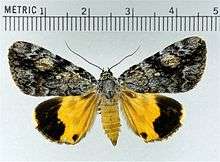
- Catocala benjamini benjamini
Benjamin's underwing - Catocala carissima
carissima underwing 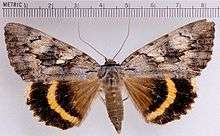 Catocala cerogama
Catocala cerogama
yellow-banded underwing- Catocala concumbens
pink underwing - Catocala connubialis f. sancta
connubial underwing - Catocala delilah
Delilah underwing - Catocala grotiana
Grote's underwing 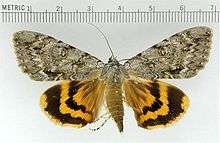 Catocala habilis
Catocala habilis
habilis underwing- Catocala hermia f. diantha
Hermia underwing 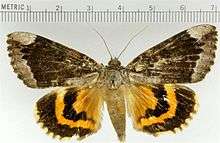 Catocala innubens
Catocala innubens
betrothed underwing- Catocala irene
Irene's underwing - Catocala jessica
Jessica underwing - Catocala meskei f. rosalinda
Meske's underwing 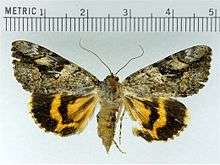 Catocala micronympha
Catocala micronympha
little nymph underwing- Catocala neogama euphemia
the bride  Catocala obscura
Catocala obscura
obscure underwing- Catocala piatrix dionyza
penitent underwing - Catocala relicta f. elda
the relict - Catocala retecta luctuosa
yellow-fringed underwing 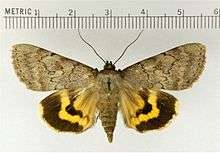 Catocala serena
Catocala serena
serene underwing Catocala ultronia
Catocala ultronia
dark red underwing- Catocala unijuga
once-married underwing - Catocala verrilliana f. beutenmuelleri
Verrill's underwing
Other "underwing moths"
As noted in the introduction, some species besides the Catocala species are also commonly known as "underwings". Typically however, the name is used with a qualifier, such as a color term, in these cases. Non-Catocala "underwing moths" are typically owlet moths, namely: Subfamily Catocalinae
- Beautiful yellow underwing (Anarta myrtilli)
- Brown underwing (Minucia lunaris)
- Locust underwing (Euparthenos nubilis)
- (European) white underwing (Catephia alchymista) – in North America, "white underwing" typically refers to Catocala relicta
Subfamily Amphipyrinae
- Copper underwing (Amphipyra pyramidea)
- Svensson's copper underwing (Amphipyra berbera)
Subfamily Erebinae
- False underwing moth (Allotria elonympha)
Subfamily Hadeninae
- Black underwing (Mormo maura)
- Blossom underwing (Orthosia miniosa)
- Broad-bordered white underwing (Hadula melanopa)
- Guernsey underwing (Polyphaenis sericata)
- Lunar underwing (Omphaloscelis lunosa)
- Small dark yellow underwing (Coranarta cordigera)
- Small yellow underwing (Panemeria tenebrata)
- Straw underwing (Thalpophila matura)
Subfamily Noctuinae
- Pearly underwing (Peridroma saucia)
- Yellow underwings proper, some 15 species in the genus Noctua
However, the "orange underwings" are two species of genus Archiearis of the geometer moth family (Geometridae):
- Orange underwing (Archiearis parthenias)
- Light orange underwing (Archiearis notha)
Footnotes
- ↑ FE (2011), and see references in Savela (2012)
- ↑ Hampson G. F. (1892). "The Fauna of British India Including Ceylon and Burma, Moths Vol. II". Digital Library of India. p. 558. Retrieved 4 July 2016.
- ↑ Fullard & Napoleone (2001), Stevens (2005)
- ↑ Nelson & Loy (1983), and see references in Savela (2012)
- ↑ Fullard & Napoleone (2001)
- ↑ Woodhouse (1910)
- ↑ See references in Savela (2012)
- ↑ Pitkin & Jenkins (2004b)
- ↑ "Blepharonia" was initially proposed as name for a tribe in 1823, and only established as a genus name Blepharonia in 1825: Pitkin & Jenkins (2004a).
References
- Fauna Europaea (FE) (2011): Catocala. Version 2.4, 2011-JAN-27. Retrieved 2012-MAR-29.
- Fullard, James H. & Napoleone, Nadia (2001): Diel flight periodicity and the evolution of auditory defences in the Macrolepidoptera. Animal Behaviour 62(2): 349–368. doi:10.1006/anbe.2001.1753 PDF fulltext
- Nelson, John M. & Loy, Peter W. (1983): The Underwing Moths (Lepidoptera: Noctuidae) of Oklahoma. Proceedings of the Oklahoma Academy of Science 63: 60-67. PDF fulltext
- Pitkin, Brian & Jenkins, Paul (2004a): Butterflies and Moths of the World, Generic Names and their Type-species – Blepharonia Hübner 1823. Version of 2004-NOV-05. Retrieved 2012-MAR-29.
- Pitkin, Brian & Jenkins, Paul (2004b): Butterflies and Moths of the World, Generic Names and their Type-species – Catocala. Version of 2004-NOV-05. Retrieved 2012-MAR-29.
- Savela, Markku (2012): Markku Savela's Lepidoptera and some other life forms – Catocala. Version of 2012-FEB-05. Retrieved 2012-MAR-29.
- Stevens, Martin (2005): The role of eyespots as anti-predator mechanisms, principally demonstrated in the Lepidoptera. Biological Reviews 80(4): 573–588. doi:10.1017/S1464793105006810 PDF fultlext
- Woodhouse, S. C. (1910): English-Greek Dictionary – A Vocabulary of the Attic Language. George Routledge & Sons Ltd., Broadway House, Ludgate Hill, E.C. Searchable JPEG fulltext
Further reading
- Ishizuka, K. (2002). "Notes on Catocala columbina Leech, 1900 (Lepidoptela, Noctuidae), with description of new taxa." Gekkan-Mushi (379): 12-13.
- Ishizuka, K. (2007). "A new species of Catocala Schrank, 1802 from Western China (Lepidoptera, Noctuidae)." Gekkan-Mushi (439): 22-24.
- Kravchenko, V. D. et al. (2008). "New underwing taxa of the section of Catocala lesbia Christoph, 1887 (Lepidoptera: Noctuidae)." Acta Zoologica Lituanica 18(1): 30-49.
- Kravchenko, V. D., Speidel, W., et al. (2008). "A new species of Catocala from Israel (Lepidoptera: Noctuidae)." Acta Zoologica Lituanica 18(2): 127-129.
- Leech, J. J. (1900). Transactions of the Entomological Society of London 1900: 511-663.
- Lewandowski, S. & Tober, K. (2008). "Catocala olgaorlovae duschara subspec. nov. aus Jordanien (Lepidoptera: Noctuidae)." Atalanta 39(1-4): 377-378.
- Saldaitis, A. & Ivinskis, P. (2008). "Catocala florianii, a new species (Lepidoptera: Noctuidae) from China." Acta Zoologica Lituanica 18(2): 124-126.
- Saldaitis, A. & Pekarsky, O. & Borth, R. (2014). "A new subspecies of Catocala pudica Moore, 1879 (Lepidoptera: Noctuidae (sensu lato): Erebinae) from Mongolia." Esperiana 19: 255–262.
- Sinyaev, V., Saldaitis, A. & Ivinskis, P. (2007). Acta Zoologica Lituanica 17(4): 272-275.
- Speidel, W., Ivinskis, P. & Saldaitis, A. (2008). "A new Catocala species (Lepidoptera: Noctuidae) from China." Acta Zoologica Lituanica 18(2): 122-123.
- Weisert, F. (1998). Zeitschrift der Arbeitsgemeinschaft der Österreichischen Entomologen 50: 125-126.
External links
| Wikimedia Commons has media related to Catocala. |
